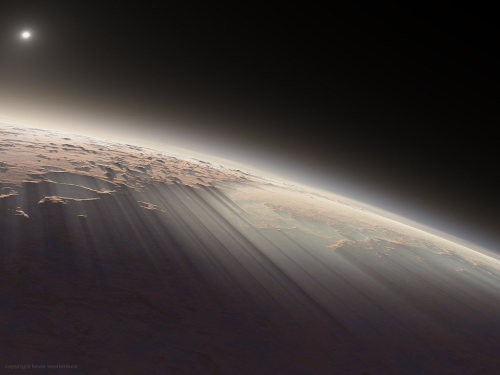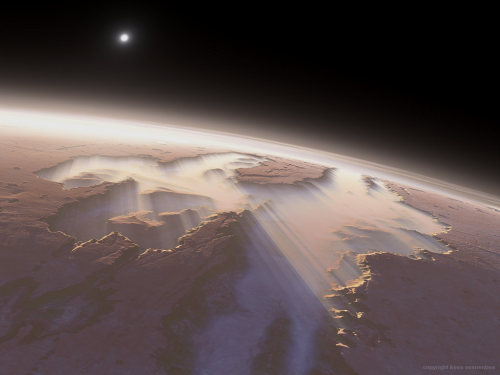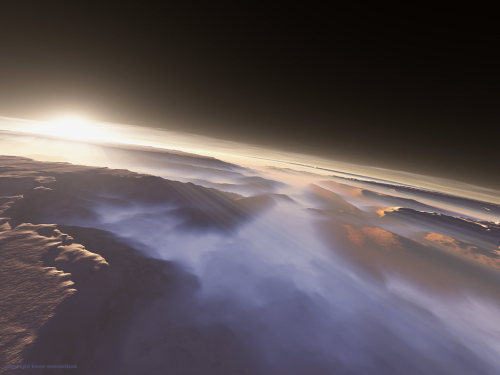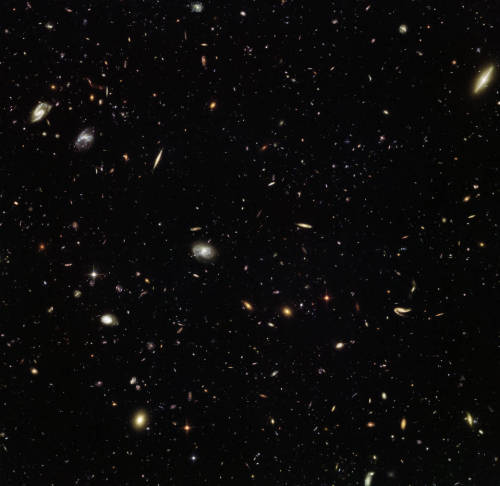Morning On Mars






Morning On Mars
Martian sunrises, as seen by the HiRISE orbiter
More Posts from Littlecadet-biguniverse and Others

The Running Chicken Nebula.
Image Credit & Copyright: Andrew Campbell

Infrared Saturn Clouds via NASA http://ift.tt/2b5OdPE


Amazing photo of the south pole of Mars.


Top: Hubble’s infrared vision pierced the dusty heart of our Milky Way galaxy to reveal more than half a million stars at its core. At the very hub of our galaxy, this star cluster surrounds the Milky Way’s central supermassive black hole, which is about 4 million times the mass of our sun.
Credits: NASA, ESA, and Hubble Heritage Team (STScI/AURA, Acknowledgment: T. Do, A.Ghez (UCLA), V. Bajaj (STScI)
Bottom: This annotated, infrared image from the Hubble Space Telescope shows the scale of the galactic core. The galaxy’s nucleus (marked) is home to a central, supermassive black hole called Sagittarius A-star.
Credits: NASA, ESA, and the Hubble Heritage Team (STScI/AURA) Acknowledgment: T. Do, A.Ghez (UCLA),V. Bajaj (STScI)

Galaxy Ngc474

Hubble peers billions of light years away, uncovering thousands of colorful galaxies clustered together in the constellation of Leo (The Lion). Galaxy clusters are so massive that their immense gravity warps and amplifies the light from more distant objects. This phenomenon, known as gravitational lensing, can help astronomers reveal the earliest galaxies in our universe.

Infrared VISTA view of a stellar nursery in Monoceros
js

Milky Way over Shelbyville, Indiana
js
-
 sandra-lovie liked this · 1 month ago
sandra-lovie liked this · 1 month ago -
 fullmingos reblogged this · 1 month ago
fullmingos reblogged this · 1 month ago -
 robobirdie liked this · 1 month ago
robobirdie liked this · 1 month ago -
 swiggityswellgotohell reblogged this · 1 month ago
swiggityswellgotohell reblogged this · 1 month ago -
 donkeykong1776 reblogged this · 1 month ago
donkeykong1776 reblogged this · 1 month ago -
 bishopdane liked this · 1 month ago
bishopdane liked this · 1 month ago -
 donkeykong1776 liked this · 1 month ago
donkeykong1776 liked this · 1 month ago -
 operator556 liked this · 1 month ago
operator556 liked this · 1 month ago -
 elusiveladydjinn reblogged this · 1 month ago
elusiveladydjinn reblogged this · 1 month ago -
 elusiveladydjinn liked this · 1 month ago
elusiveladydjinn liked this · 1 month ago -
 groovyleviathan liked this · 1 month ago
groovyleviathan liked this · 1 month ago -
 vigorous1 reblogged this · 1 month ago
vigorous1 reblogged this · 1 month ago -
 nero-neptune reblogged this · 1 month ago
nero-neptune reblogged this · 1 month ago -
 hornet-f-18 liked this · 1 month ago
hornet-f-18 liked this · 1 month ago -
 catsandwildlife liked this · 1 month ago
catsandwildlife liked this · 1 month ago -
 fogandfireflies liked this · 1 month ago
fogandfireflies liked this · 1 month ago -
 warxpunkxmonk liked this · 2 months ago
warxpunkxmonk liked this · 2 months ago -
 thebluecallsme reblogged this · 2 months ago
thebluecallsme reblogged this · 2 months ago -
 thebluecallsme liked this · 2 months ago
thebluecallsme liked this · 2 months ago -
 celestialcatsworld liked this · 2 months ago
celestialcatsworld liked this · 2 months ago -
 l4t21 liked this · 2 months ago
l4t21 liked this · 2 months ago -
 nachtdoler liked this · 2 months ago
nachtdoler liked this · 2 months ago -
 zomb59 reblogged this · 2 months ago
zomb59 reblogged this · 2 months ago -
 zomb59 liked this · 2 months ago
zomb59 liked this · 2 months ago -
 nessieac liked this · 2 months ago
nessieac liked this · 2 months ago -
 iwillruletheuniverse reblogged this · 2 months ago
iwillruletheuniverse reblogged this · 2 months ago -
 peacockfire reblogged this · 2 months ago
peacockfire reblogged this · 2 months ago -
 deadlycrimson reblogged this · 2 months ago
deadlycrimson reblogged this · 2 months ago -
 ohfallingstar reblogged this · 2 months ago
ohfallingstar reblogged this · 2 months ago -
 chaoticpersontale liked this · 2 months ago
chaoticpersontale liked this · 2 months ago -
 1darkflame7 liked this · 2 months ago
1darkflame7 liked this · 2 months ago -
 solemnrose reblogged this · 2 months ago
solemnrose reblogged this · 2 months ago -
 desperad0 reblogged this · 2 months ago
desperad0 reblogged this · 2 months ago -
 kinderfeld reblogged this · 2 months ago
kinderfeld reblogged this · 2 months ago -
 heavenstrvck reblogged this · 2 months ago
heavenstrvck reblogged this · 2 months ago -
 tummyachesurvivor77 liked this · 2 months ago
tummyachesurvivor77 liked this · 2 months ago -
 nymphtmnn reblogged this · 2 months ago
nymphtmnn reblogged this · 2 months ago -
 jahoshwa reblogged this · 2 months ago
jahoshwa reblogged this · 2 months ago -
 hushabyepuppy reblogged this · 2 months ago
hushabyepuppy reblogged this · 2 months ago -
 hushabyepuppy liked this · 2 months ago
hushabyepuppy liked this · 2 months ago -
 midnightmiscreant liked this · 2 months ago
midnightmiscreant liked this · 2 months ago -
 norageonlypancakes reblogged this · 2 months ago
norageonlypancakes reblogged this · 2 months ago -
 wolfsong-the-bloody-beast reblogged this · 2 months ago
wolfsong-the-bloody-beast reblogged this · 2 months ago -
 cutelovebird reblogged this · 2 months ago
cutelovebird reblogged this · 2 months ago
GREETINGS FROM EARTH! Welcome to my space blog! Let's explore the stars together!!!
144 posts